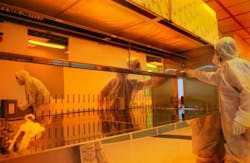Cleanrooms are an important part of manufacturing processes, scientific research and quality control. Whatever their intended purpose, setting up a cleanroom requires careful consideration both in the design phase, and then in how you use it.
What is a cleanroom?
In simple terms, a cleanroom is a controlled area within a wider facility that maintains a specific level of air particles and other contaminants. The three ways in which a cleanroom is clean are:
- The air quality is controlled
- All surfaces and equipment are always cleaned to a certain standard
- It is operated in a specific way — for example, the number of staff is limited
Why you might need a cleanroom
There are a variety of reasons why a company needs a cleanroom. You may be manufacturing a material that is easily contaminated by airborne particles, or it may be too hazardous to manufacture in an open environment. Industries which commonly need cleanrooms include:
- Pharmaceutical
- Medical
- Electronics
- Aerospace
- Research facilities
- Chemical suppliers
- Military
How to set up a cleanroom
The International Organization for Standardization (ISO) provides standards for cleanroom set up and operation.
Setting up a cleanroom starts with the design phase. During this phase you should consider how the cleanroom will be used, permitted particle concentration, its location, the manufacturing process requirements and cost. It will be necessary for the cleanroom designers to have in-depth conversations with the end users to ensure that all needs are captured in this phase.
Design requirements will generally depend on your industry, and within that on whether the material being processed in the clean room is hazardous or non-hazardous.
12 points to consider when setting up a cleanroom
There are many elements to take into consideration when you set up a cleanroom. Along with the practicalities of how much space you have and how much space you need for your equipment, you also need to consider:
- HEPA (High Efficiency Particulate Air) filters: These filters support contamination control by filtering particles as small as 0.3 microns. Air should be continually circulated through HEPA filters to remove contaminants in the air and to supply fresh air for people working in the cleanroom.
- Ventilation: Ventilation is required to maintain air quality and replace process exhaust. This is very energy-intensive, so you need extra space for cooling unit components as well as larger air passageways, noise suppressors, a backup generator and large intake and exhaust stacks.
- Air pressure: Cleanrooms should have a static pressure which is higher than atmospheric pressure in order to prevent infiltration by wind. Airlocks also help minimize or prevent changes in pressure that could compromise the process.
- Temperature and humidity: Temperature control means stable and consistent conditions for materials and equipment. Humidity control prevents corrosion and condensation of internal surfaces and eliminates static electricity. These two factors are integral to the function of a clean room as well as to the comfort of the people working within it.
- Architecture: In order to maintain a consistent air flow throughout the cleanroom, the air needs as unrestricted path as possible. If air flow is restricted, the resulting turbulence can then cause movement of particles which in turn raises the risk of airborne contaminants.
- Measuring equipment: A cleanroom needs to be constantly measured to ensure that factors such as particle count, air flow, humidity, temperature, and cleanliness are at the appropriate levels.
- Electrostatic discharge: Moving air and moving people both create an electrical charge. Electrostatic discharge protective materials should be used to prevent potential damage.
- Lighting: A dimly lit cleanroom won’t do you any favors. You won’t be able to clean properly so particles will build up, and you may misread instrument displays. Lighting in a cleanroom should be consistent and uniform with few dark spots.
- Future-proofing: Make sure your cleanroom is as flexible in design as possible to accommodate future expansion, new equipment or changes to processes.
- Materials used for internal surfaces: In a cleanroom, you cannot use any surface material that may shed particles and contaminate the air. They also need to be resistant to breakdown when cleaned, so they need to be compatible with your cleaning products.
- Showers and laundry facilities: This will depend on your requirements and materials, but you may need to provide showers and laundry facilities for decontamination purposes. This means you will need to consider plumbing and hazardous waste treatment.
- Hazardous materials: If your cleanroom handles hazardous materials, extra considerations include using a negative air pressure system and the special treatment of waste air, as well as personal protection, and separate entrances and exits.
Certifying your cleanroom
Cleanrooms should be validated and certified, which means undergoing a number of tests. It should also be regularly monitored and revalidated to ensure the standards are up to date.
There are various types of cleanroom certifications depending on your geographic location and the purpose of your clean room. The International Standards Organization (ISO) controls the latest standards and classifications for cleanrooms, and you must meet these standards in several categories in order to get cleanroom certification.
Operating a cleanroom
Once you have set up your cleanroom, it needs to be maintained with care to preserve its integrity. This means taking care to minimize contamination risks, limiting access to a small number of trained employees at a time, regular cleaning and maintenance, constant monitoring and frequent recertification.







